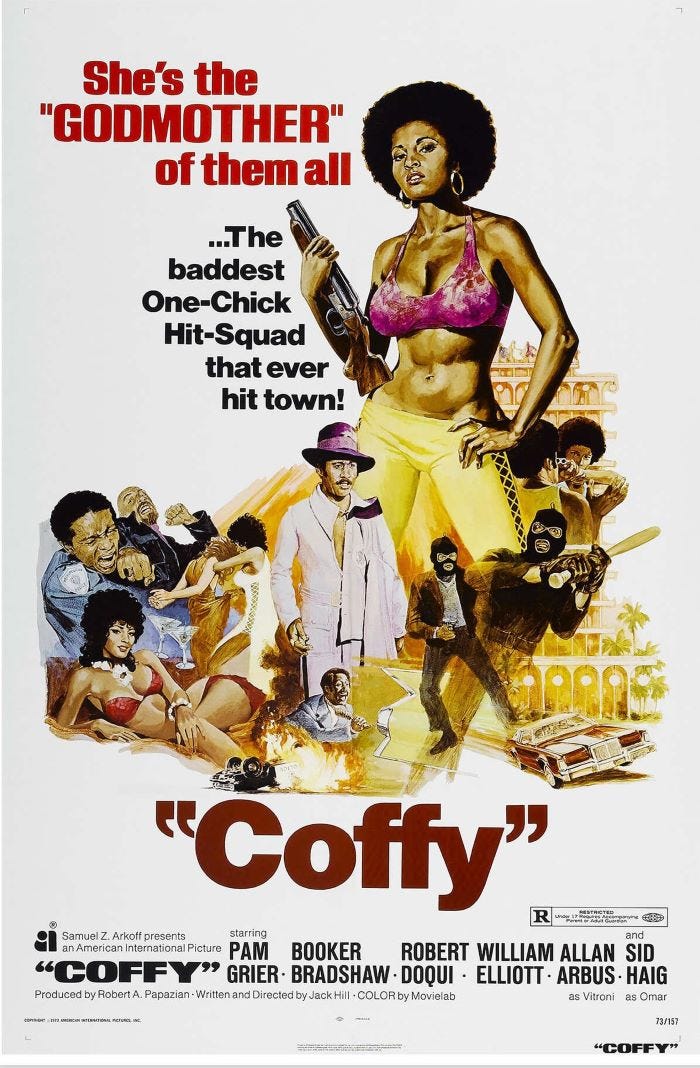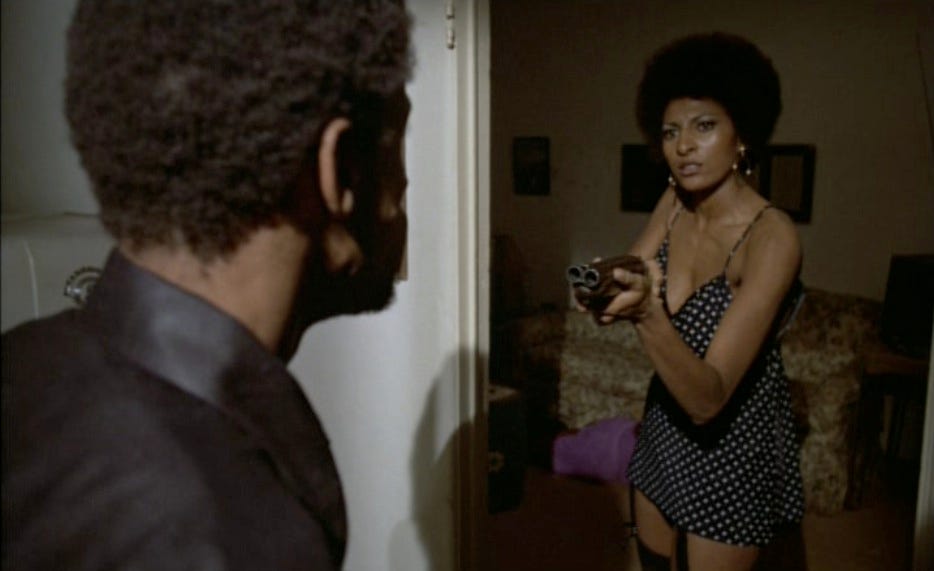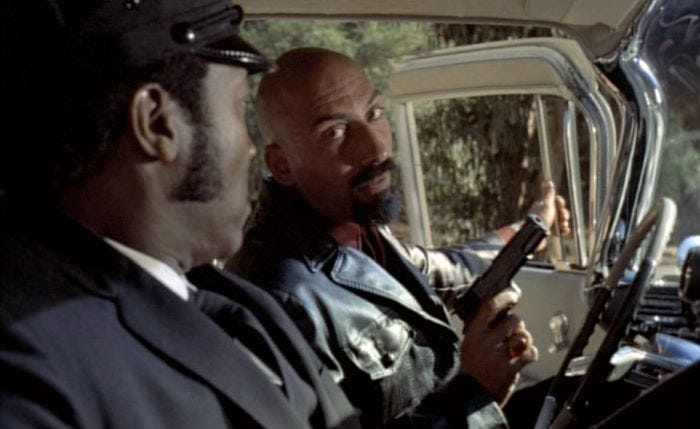Blaxploitation Education: Coffy
Witness the birth of one of Blaxploitation's biggest superstars.
Coffy
Written and directed by Jack Hill
1973
During the Blaxploitation era, there were a few stars that rose to the top, becoming headliners and being able to sell movies on their names alone. Richard Roundtree was one of the most prominent, although he didn’t make all that much of a splash outside of Shaft and its sequels. Fred Williamson provided a consistently solid and charismatic presence in movies like Hammer. Jim Brown brought his facility as a good character actor to starring roles, serving as an intense, strong-willed leading man in films like Slaughter and Black Gunn. While these types of tough-guy actors were the biggest stars of the genre, there’s one woman who could stand alongside them: Pam Grier.
Grier had showed up in a few Blaxploitation movies by 1973, usually filling small supporting roles. She had memorable turns in Cool Breeze and Hit Man, as well as a co-leading role in Black Mama, White Mama. But Coffy was her big breakout movie, giving her the chance to play a tough action hero. And she totally rises to the occasion, making the character smart and strong, with a will to survive and get revenge on those who had wronged her, while also showing some vulnerability, highlighting her femininity, and getting to be stylish and confident throughout. It’s the star-making role she deserved, and luckily, she has a fun movie built around her to make it as memorable as possible.
A lot of credit can probably be given to writer/director Jack Hill, a master of exploitation movies who wasn’t satisfied with delivering the expected elements (violence, nudity, the works), but took the care to develop memorable characters and put them in compelling situations. He certainly does that here, crafting a revenge plot in which the title character is looking to take down the major players in the Los Angeles drug trade, and even if she does get in over her head, she manages to succeed.
The opening scenes of the movie see a drug dealer named Sugarman (Morris Buchanan, who was in at least a couple other Blaxploitation movies) get approached by one of his pushers, who tells him that he has a really hot girl in his car who is jonesing for a fix. Sure enough, it’s Pam Grier, and she says she’s ready to have lots of sex with Sugarman if he’ll just give her some drugs. But when they take her back to Sugarman’s place, she suddenly pulls out a shotgun, lets him know that she’s getting revenge for a little sister who has had her life ruined by drugs, then blows his head off.
That’s a hell of a character introduction, and while it’s the beginning of a quest for revenge that will last the rest of the movie, Grier doesn’t treat her character as a remorseless woman of action who stalks through the underworld to destroy everyone who opposes her. She’s shaken by her actions, and when she goes to her job as an emergency room nurse, she can barely concentrate. She happens to meet an old flame of hers, a Black police officer named Carter (William Elliot), but even though she’s not interested in rekindling their relationship due to the thing she has going with Howard, a local city council member who is getting ready to campaign for Congress (Booker Bradshaw), she’s still friendly with him. As the two of them spend some time together, she questions whether there’s anything that can be done about the drug trade that is ravishing the Black community. He doesn’t seem too hopeful, knowing that even the police can only do so much, especially when so many of them are corrupt. When he turns down some bribes and gets beaten nearly to death in response, this solidifies Coffy’s belief that the only solution is some vigilante justice.
Her quest leads her to a major pimp and drug dealer in LA known as King George (Robert DoQui), who she learns is working for a drug kingpin named Vitroni (Allan Arbus). She manages to get into George’s good graces by posing as a Jamaican woman (complete with an atrocious accent) and seeking to join his stable, which immediately earns the ire of all of his other women. This leads to a pretty wild fight scene between Coffy and several other girls at a party, which includes her use of a secret weapon: razor blades secreted in her afro.
Coffy’s spunk gains the attention of Vitroni, who insists that he has to have sex with her. She knows of his proclivities, in which he likes to demean women, spit on them, and force them to crawl on the floor and beg for his favor, but while she does play along at first, she responds to the racial slurs he slings by pulling out a gun and attempting to kill him. Unfortunately, her plans are foiled by Vitroni’s thug, Omar (Sid Haig, a common foil for Grier, including some memorable roles in The Big Doll House and Black Mama, White Mama).
While Coffy gets held captive, she learns that her boyfriend the politician is actually in league with the drug dealers, and he seems to have no regrets about throwing her under the bus, referring to her as “some chick I fuck sometimes” and telling them to go ahead and kill her. As if she didn’t have it already, this gives her even more motivation to escape and effect some violent revenge on all of them.
The plot here is fairly rudimentary, but the details make it sing. There’s just enough specificity to the ways the characters behave to keep everything from seeming like a generic tale of revenge, and the dialogue and performances sell the somewhat silly nature of the proceedings, making everything have real stakes. Haig is especially good as a vicious killer who sports a shaved head, a goatee, and a vaguely European accent, but while he gets to relish in his sadism, he also makes himself look pretty pathetic when Coffy turns the tables on him. Bradshaw is also good, making his character memorably slimy and two-faced. He sells the idea of a politician who is eloquent and convincing enough to make people think he might actually have their best interests at heart before his true nature is revealed.
But of course, Grier is the real draw here, getting to exhibit a full range of emotions. She makes the anguish she’s feeling early on believable, showing that she’s conflicted about whether violence is really the answer. But once she fully embarks on her mission, she’s cool and confident, ready to use her street smarts and her strength of will to succeed. She makes you believe that she could get a pimp who has probably seen it all to believe that she’s ready to service high-class clients for him, and when the other women try to mess with her, she plots her response and then brazenly takes all of them on. Later, when she gets captured, she seems shocked by Howard’s betrayal, but she’s also ready with her escape plan, and once she gets the chance, she coldly executes the bad guys one by one. In her final confrontation with Howard, she almost seems moved by his pleas and his claims that his ultimate goal is to help the Black community, but when his true nature becomes evident, she doesn’t hesitate to kill him in the most painful way possible.
So yes, Pam Grier is awesome, and this movie is built to demonstrate that awesomeness to its full effect. Jack Hill knew how to craft a solid exploitation movie plot, and he provides all the details to make everything work like gangbusters. If there’s anything to complain about, it’s probably the songs on the soundtrack, which are pretty corny (the opening credits song, “Coffy Is the Color,” is passable, but a later song called “Coffy Baby” is pretty bad, and the less said about the spoken-word “King George,” the better). The score by Roy Ayers is pretty good though, providing a decent example of the funky guitar- and horn-driven style that was becoming standard in the Blaxploitation genre at this point. But regardless of what we hear in the background, the action and performances taking place on screen are some of the most entertaining the genre ever produced. If there’s a list of Blaxploitation movies that need to be seen to provide a complete picture of the genre, this would most likely be on it.
Blaxploitation Education index:
UpTight
Cotton Comes to Harlem
Watermelon Man
The Big Doll House
Shaft
Sweet Sweetback’s Baadasssss Song
Super Fly
Buck and the Preacher
Blacula
Cool Breeze
Melinda
Slaughter
Hammer
Trouble Man
Hit Man
Black Gunn
Bone
Top of the Heap
Across 110th Street
The Legend of N***** Charley
Don’t Play Us Cheap
Shaft’s Big Score!
Non-Blaxploitation: Sounder and Lady Sings the Blues
Trick Baby
The Harder They Come
Black Mama, White Mama
Black Caesar
The Mack
Book of Numbers
Charley One-Eye
Ganja & Hess
Savage!









The best song on Ayers' soundtrack is arguably "Shining Symbol", which illustrates the film's principal theme while also implying the symbolism of Grier's character to the wider world.